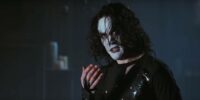From box office flop to legendary cult classic, Hocus Pocus has cast a spell to turn its luck around full circle. When virgin Max (Omri Katz) jokingly lights the Black Flame Candle on Halloween night, he gets more than he bargained for when he unintentionally resurrects the three Sanderson Sisters from their afterlife in Hell to wreak havoc on his new hometown of Salem, Massachusetts. A town with significant history when it comes to witches, this is a suiting setting for a night of comedic mishaps and attempts to send the witches back to their graves for good.
Freeform has been airing the movie over and over this October, as it does each year, to celebrate the spooky holiday and to appease the demands of the fans. Its comedy is certainly prominent; from the sisters’ freak outs to all things modern (screaming at a firetruck, getting confused by children in costumes engaging in a “night of frolic”) and Max, his crush Allison (Vinessa Shaw), his little sister Dani (Thora Birch) and former human-turned-black-cat Binx running amok trying to do damage control.
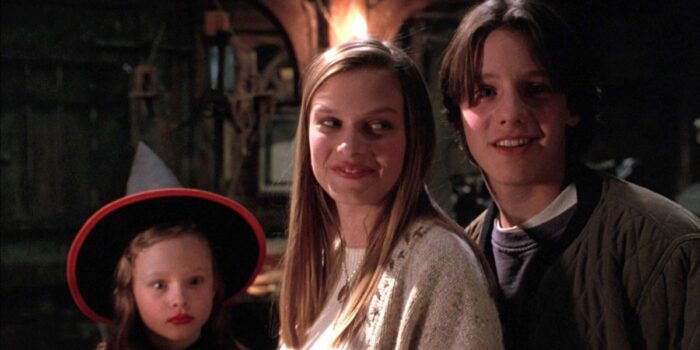
While the Sanderson Sisters (Bette Midler, Sarah Jessica Parker, Kathy Najimy) may be portrayed as the bumbling village idiots, if you will, they are quite capable of true and pure evil. The fact is, is that it’s just overlooked because the audience is too busy laughing at their antics. Sarah is boy-crazy and airheaded, Mary is a tad dubious and all for calming circles, and Winifred is controlling, manipulative and obsessed with power. Winifred is essentially the Dictator of the Sanderson Sisters, but audiences love her anyway. “Another glorious morning…makes me sick!” earns Winifred points on the relatability scale, especially for night owls that hiss at the morning light.
Horror hides in the darkest depths of this movie, and among the Sanderson Sisters. Stopping to consider it now in itself will likely instil an irreversible curse consisting of the Sanderson Sisters losing a certain level of likability. You may love the movie and its book sequel, but you’ve never seen it like this.
Masked Horror Effects
According to this article, there are a few elements that make a horror film, a horror film. Upon some introspection, we’ve linked segments of the film to the ingredients of horror films in general. Moving forward you can’t go back, so this is your final warning, lest your favorite childhood Halloween movie forever be ruined for you.
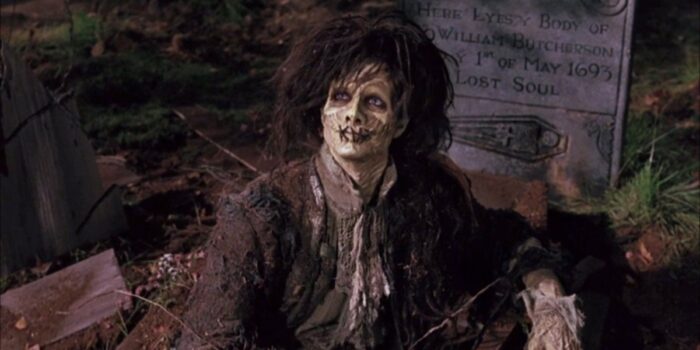
Disfigurement. It’s something you don’t see every day, so there’s a certain level of wariness and even fear associated with something like this. Movies like A Nightmare on Elm Street have taken this quite seriously with the appearance of Freddy Krueger. The claws, the melted face. It’s grotesque and you can’t help but flinch a little when you see him, even if you’ve seen the movie a thousand times before.
Now, Hocus Pocus downplays this element but it still exists in the form of Billy (Doug Jones). Awakened from the undead, he spends most of the movie chasing the three kids and Binx around town. He doesn’t exactly exude prime condition after being dead for three hundred years, so his appearance is off-putting. Plus, the other horror element of dismemberment can be applied to Billy, who loses both his head and his fingers in the film. He may turn out to be a good guy, but he’s still a portrayal of horror.
Next up, we have creepy crawlies. Spiders, snakes, rodents. You get the picture. Unfortunately, these things exist outside of movies, but feature films somehow amplify the scariness of these things. On purpose, of course. Hocus Pocus had Sarah eating a spider (um, ick!) and the three kids underground facing mice. Binx may be comfortable with it (according to him he’d been hunting under the cemetery for years), but the kids definitely weren’t. They’d just barely escaped another encounter with the dreaded trio of sisters and then wound up with mice under a graveyard. Definitely not on most people’s to-do list.
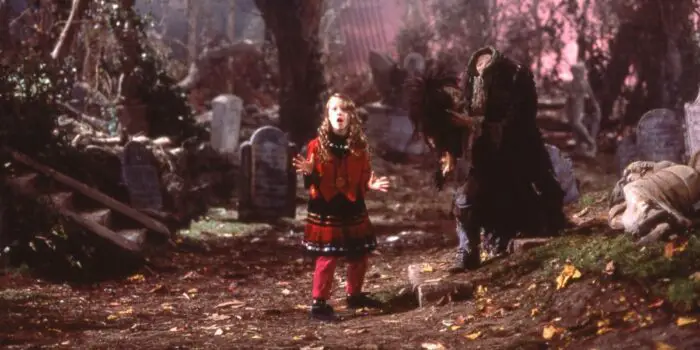
Speaking of graveyards, that brings us to yet another horror movie staple: spooky locations. Haunted houses. Boiler rooms. Jungles. Basements. Attics. The works. The primary sinister locations in this movie are the graveyard and the Sanderson house (it could definitely be considered haunted). A significant chunk of the movie takes place in the graveyard, including the final showdown in which Max takes Dani’s place and nearly has his life force sucked out of him. If anything, this movie just makes the spookiness of a cemetery even more intense. Good news is, it’s hallowed ground. If you’re being chased by witches, you’ll be safe from everything but an aerial attack. Sanctity isn’t perfect.
The night. Many kids are scared of the dark. Plenty of movies have taken advantage of this factor by incorporating monsters in the closet, creatures jumping out of bushes or otherwise instilling a severe spine-chilling association with the dark. Hocus Pocus primarily takes place overnight as the kids race around Salem trying to both avoid and defeat the Sandersons. Sometimes the cover of nightfall can be beneficial so as to surprise your enemy, but it’s also just plain eerie.
Spooky music. You’re probably thinking of the famed theme from Halloween, the dreaded Jaws theme that ruined swimming for everyone or the creepy “One, two, Freddy’s coming for you…” song originating from A Nightmare on Elm Street. The music ups the ante, whether it’s for a scene featuring a confrontation with the monster, a special theme for a specific character or perhaps most famously, the chase scene music. Hocus Pocus places a twist on this bit, turning what should be a horrifying song into a sing-along. “I Put A Spell On You” caught on like wildfire and you can’t help but become part of the chorus. Still, when it comes down to it, it’s a song meant to cast a dreadful spell, and it notably sidelines the adults, leaving Max, Allison, Dani and Binx to their own devices to save Salem from ruin.

Now, think about the Sanderson Sisters themselves. When we first meet them, they’re looking worse for wear. Essentially they are disturbingly creepy old ladies singing about dead toes and making a potion of destruction. Even when they steal the life force of poor Emily Binx (Amanda Shepherd) and are rendered younger, their appearances are still unruly. From their costumes to their hairstyles to Winifred’s buck teeth and Mary’s down-turned mouth, they are a force to be reckoned with when it comes to fear of the unusual, another noteworthy horror detail.
People fear the things they can’t understand. This includes coming across people, animals or things that especially stand out from everyone else. You could certainly pick any of the three Sandersons out of a lineup, and you would remember them even if you only saw them once. They’re hard to forget. They may not be covered in blood, have scaly skin or warts on their noses like some witches do, but they are unusual in their own way. Three women aren’t scary. Three women looking like the Sandersons do—now that’s a beast of a different nature.
Suspense. How could we forget this classic horror component? Alfred Hitchcock was one of the best filmmakers to elicit suspense, particularly with Psycho and North by Northwest. The most powerful examples of suspense that Hocus Pocus has to offer include Thackery’s (Sean Murray) failed attempt to save his sister, Binx’s near-death after being hit by a bus (that ironically Sarah was driving), and the film’s climax in which all the children of Salem are lured to the Sanderson home. The biggest question of all was whether or not Max, Allison, Dani and Binx would succeed in stopping the Sandersons not just on Halloween night 1993, but for all the Halloween nights to come for eternity. You certainly don’t want them rising from Hell twice.
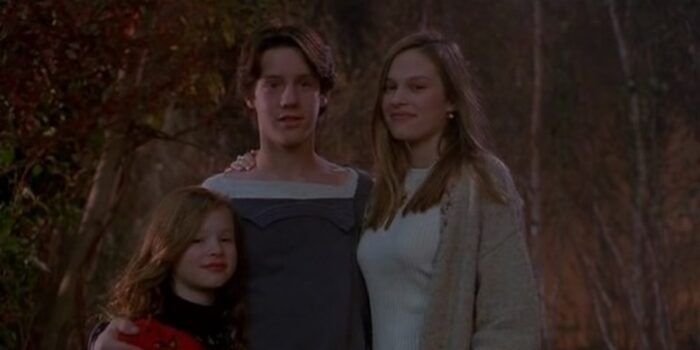
Last but certainly not least, we come down to what may be number one on the constituents that make a horror film. Fear of death. Death is scary because we don’t know what happens afterwards. Many people have different beliefs in regard to that but no one can actually prove what happens next. Fear of death is only heightened when you’re chased by a crazed killer in which impending death seems very likely. Max, Allison, and Dani fear for their lives throughout the movie—especially Dani, who becomes the principal target of the Sandersons. The Sandersons get their kicks out of infusing fear of death in the community. As witches, they are capable of more evildoing than most. Taking innocent children by luring them against their will? That’s the greatest fear of death anyone can generate.
On a last note, while the Sandersons are predominantly portrayed as inept, they are still child murderers. They killed Emily, didn’t they? Not to mention they tried to do the same to Dani, and to all the other children of Salem in 1993. Labeling them by their true identities as child murderers adds a perverted and depraved vibe to them, but if you were to tell the sisters this to their faces, they’d probably think it was hilarious—and then kill you too just for inconveniencing them.
The Boiling Point
All these reasons support the underlying truth that Hocus Pocus, though disguised as a harmless children’s movie, hides darker meanings within its make-up. It possesses too many facets of the quintessential horror movie to ignore evidence. Though it’s hard to confront, this childhood favorite movie could possibly be compared to the likes of Halloween. After all, Michael Myers was also a child murderer. As was Freddy Krueger, for that matter.
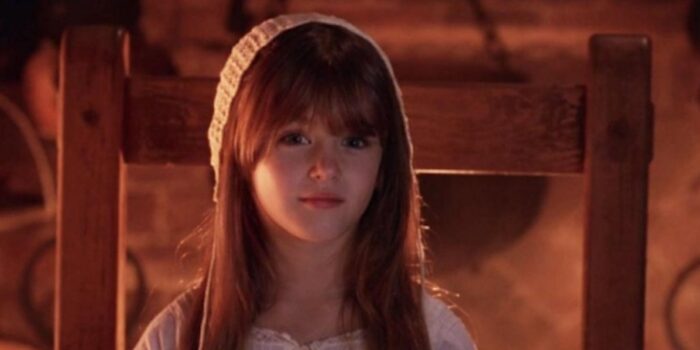
The Sandersons are selfish, that’s a given. They only look out for each other (though Winifred prioritizes herself most of the time). They don’t care who they have to harm to get what they want (especially where it comes to their beauty and immortality). Their primary targets are always children. If you weigh the depth of their destruction, especially in regards to their dastardly plans to steal the life forces from all the children of Salem, it’s one of the darkest horror elements not just in film but in life. They have no limit on the number of children they kill. Only the universe knows how many innocent children they killed before Emily.
As if that weren’t disturbing enough, consider what pain Emily must have endured in her final moments. We only saw her slumped over, but we’re not privy to exactly what happened to her as she was drained. No doubt she was traumatized over how helpless she was, and she no doubt saw her brother in his final moments as a human trying to rescue her. She was too young and innocent to die in such a manner, and Thackery didn’t deserve his fate stuck as a cat for eternity, separated from his family and friends. Emily dying may not be as gory as Michael Myers hacking up teenagers, but the Sandersons still have things to answer for as child murderers. They were willing to cause hundreds of families, if not more, infinite pain with the losses of their children to satisfy their own needs.
Needless to say, these elements are quite dark and disturbing, especially for Disney standards. Still, if you’re willing to overlook it all, then it’s still a funny movie. That is, as long as you don’t pause to consider the underlying reality.

